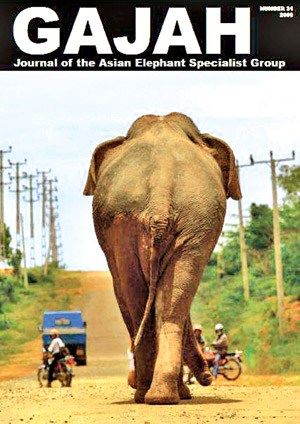Human Elephant conflicts
Jayantha Jayewardene
People living with wildlife are important players in any strategy to
conserve wildlife. This becomes more important where there are conflicts
between man and wildlife. The importance of the involvement of the local
people in wildlife conservation is because these people share resources
with wildlife and the interaction of people and wildlife affect each
other both positively and negatively.
|

Gajah. The journal of the IUCN Asian Elephant Specialist Group |
Therefore one cannot isolate local people from the conservation of
wildlife. It is also equally important to look at conservation issues
from both the point of view of conserving wildlife per se and its
socioeconomic aspects.
Human-elephant conflict (HEC) is one such issue that requires a
greater consideration of its socio economic aspects, if any mitigation
measures are to be successful. These conflicts impact on the livelihoods
of people. The declaration of protected areas takes away land that could
be used by increasing human populations for cultivation.
Agriculture in elephant habitats disrupts elephant home ranges, and
reduces the resources available to the elephants. The loss of human
lives and damage to houses and cultivations affects the livelihood of
families. It creates animosity with the elephants. Therefore if one does
not tackle these issues directly, it would be difficult to find long
term solutions to the ever increasing HEC.
Initially, when planning elephant conservation and HEC mitigation
strategies, it is necessary to meet and get the input of the communities
that are affected. The necessity for those affected by these conflicts
to take an active part in the solution of HEC in their areas cannot be
over emphasized. Without the initial input of the people the actual
situation on the ground cannot be ascertained accurately. It is also
necessary to look at these problems from their point of view instead of
making conservation decisions based on the perceptions and theories of
managers and conservationists alone.
When an elephant is killed, the carcass is buried or burnt. No
further thought is given to the effect that the death of this elephant
has on the herd. However, if a human is killed by an elephant there is
an immediate effect on the family of the deceased. Apart from the pall
of grief that descends on the family and friends of the victim, there is
an immediate negative effect on the economic status of the family,
especially if the victim was the bread winner.
A source of income, in many instances the only source, is cut off.
With this loss many changes to the life style of the family, with regard
to food, schooling, plans for the construction of a house etc., have to
be made.
The payment of compensation for the loss of human lives and loss of
property is the only action that the authorities take. In most of these
instances this compensation schemes do not meet their objectives.
Charitable schemes, which have no compensatory effect on the families of
the victims, will only ease the conscience of the authorities and show
the world that a compensation scheme is in place. What is needed is a
compensation scheme that would gradually alter the pathway of the lives
of the victimized families towards a better life.
In Sri Lanka for instance, the compensation scheme for a family where
one member has been killed by a wild elephant is the payment of Rs
50,000 (US $ 500) to the spouse. Another Rs 50,000 is divided amongst
all children under the age of 18 years. The irony of this is that each
child has to wait till he/she is over 18 years to get their due share of
money.
Another important aspect of HEC mitigation is to have accurate data
and information to go on. This becomes more important since the cause of
conflicts in one area may not be the cause for conflicts in another.
Data and the information flowing from this data, is important for
decision making, in order to evaluate the status of a problem and also
for post implementation evaluations.
HEC attracts quite a number of individuals and various organizations
who contribute to the socioeconomic development of poor families
including those victimized by elephants.
There are also researchers who work on different aspects of these
conflicts. However, there are large gaps in the data or information that
is available all over Asia. Not only is there a paucity of data and
information to plan conservation strategies but this also effects post
implementation evaluations when measuring the actual impact of
conservation and mitigation strategies.
It is absolutely necessary for research personnel and the decision
makers to join forces and coordinate their activities.
This not only strengthens the conservation plans but also makes it
possible to focus on the gaps in the data available. It is imperative
that we make use of the good work that has been done so far. With
research priorities in place the limited funds available for research
could be put to the best possible use.
Since the Governments of most Asian countries are involved in
elephant conservation, each of them should not only develop a policy for
elephant conservation but also ensure that this policy is implemented.
Sri Lanka has a policy for elephant management and conservation,
which has been approved by the highest legislature in the island, which
is a good first step. However even in Sri Lanka much needs to be done to
translate policy into action on the ground.
If the wild elephants in Asia are to be conserved effectively, there
has to be a concerted effort, by all concerned, to plan realistically,
implement these plans efficiently and evaluate them at the end to ensure
that there has been a positive impact.
This is the Editorial in the latest issue # 31 of Gajah. The journal
of the IUCN Asian Elephant Specialist Group. The writer is the editor of
Gajah. |



